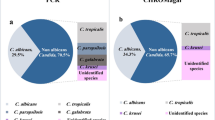Abstract
Weekly fungal surveillance cultures (1,542 cultures) of urine (475), stool (520) and oropharyngeal (547) specimens from 111 patients on the bone marrow transplant and hematologic malignancy services were analyzed. Forty-three percent of the patients were colonized by Candida albicans and 10.8 % by Candida tropicalis. There were 22 proven systemic fungal infections, ten due to Candida albicans,eight to Candida tropicalis,one each to Candida pseudotropicalis and Torulopsis glabrata,and two to Aspergillus species. Positive surveillance cultures for Candida tropicalis were highly predictive of systemic infection. The finding of two or more positive cultures yielded high positive predictive values (100%) as a function of body site. Positive surveillance cultures for Candida albicans were not predictive of disease but negative cultures for Candida albicans and Candida tropicalis had a high negative predictive value (95–99 %). Surveillance culture data for specific Candida species may aid in diagnostic and therapeutic decision making.
Similar content being viewed by others
References
Bodey, G. P.: Fungal infection and fever of unknown origin in neutropenic patients. American Journal of Medicine 1986, 80: 112–119.
Horn, R., Wong, B., Kiehn, T. E., Armstrong, D.: Fungemia in cancer hospital: changing frequency, earlier onset, and results of therapy. Reviews of Infectious Diseases 1985, 7: 646–655.
Stone, H. H., Geheber, C. E., Kolb, L. D., Kitchens, W. R.: Alimentary tract colonization byCandida albicans. Journal of Surgical Research 1973, 14: 273–276.
Kiehn, T. E., Edwards, F. F., Armstrong, D.: The prevalence of yeasts in clinical specimens from cancer patients. American Journal of Clinical Pathology 1980, 73: 518–521.
Sandford, G. R., Merz, W. G., Wingard, J. R., Charache, P., Saral, R.: The value of surveillance cultures as predictors of systemic fungal infections. Journal of Infectious Diseases 1980, 142: 503–509.
Cooper, B. H., Silva-Hutner, M.: Yeasts of medical importance. In Lennette, E. H., Balows, A., Hausier, W. J., Shadomy, H. J. (ed.): Manual of clinical microbiology. American Society for Microbiology, Washington, DC, 1985, p. 526–541.
Galen, R. S., Gambino, S. R.: Beyond normality: the predictive value and efficiency of medical diagnosis. John Wiley, New York, 1975.
Wingard, J. R., Dick, J. D., Merz, W. G., Sandford, G. R., Saral, R., Burns, W. H.: Pathogenicity ofCandida tropicalis andCandida albicans after gastrointestinal inoculation in mice. Infection and Immunity 1980, 29: 808–813.
Wingard, R.R., Merz, W. G., Saral, R.:Candida tropicalis: a major pathogen in immunocompromised patients. Annals of Internal Medicine 1979, 91: 539–543.
Author information
Authors and Affiliations
Rights and permissions
About this article
Cite this article
Pfaller, M., Cabezudo, I., Koontz, F. et al. Predictive value of surveillance cultures for systemic infection due toCandida species. Eur. J, Clin. Microbiol. 6, 628–633 (1987). https://doi.org/10.1007/BF02013057
Issue Date:
DOI: https://doi.org/10.1007/BF02013057




